Shrimp are great additions to any aquarium to help keep a tank clean and also add some visual flair. They come in many different colors and breeds with varying levels of skill level for amateur aquarists to seasoned aquarium curators. However, before diving into shrimp keeping, it’s crucial to ensure you have tank mates that will all get along! Here are some of the best tank mates to pair with shrimp, and a few that shouldn’t be kept with shrimp at all.
1. Snails (Various)
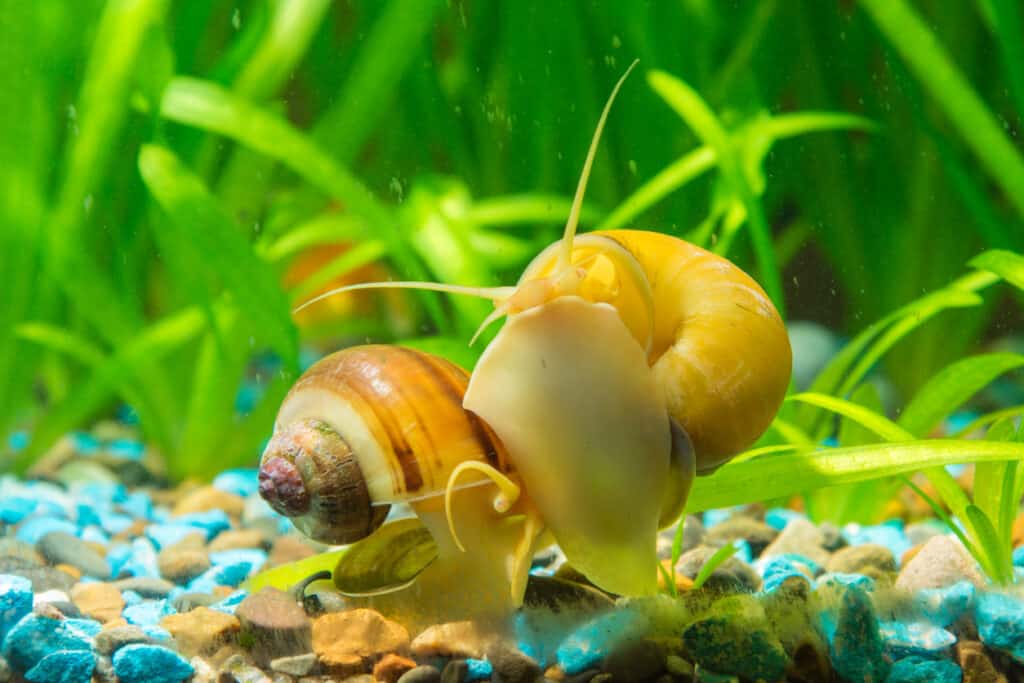
Aquarium snails can be beneficial to the environment, but watch out for population booms.
©iStock.com/Madhourse
Snails are unbothered by the presence of most tank mates and usually keep to themselves. They feed off algae, old food, and sometimes live plants in a tank. Along with shrimp, which also feed off leftover bits of food, this team’s dynamic duo will help keep your tank clean and algae-free. You have options when it comes to snails, too: assassin snails can get rid of pest snails that may come on live plants. Mystery snails (Pomaceae spp.), rabbit snails (Tylomelania spp.), and nerite snails (Neritina spp.) can easily be acquired at fish stores.
Be sure you’re still performing regular water changes, as the waste produced by both shrimp and snails can cause ammonia spikes which can be dangerous to other organisms.
2. Ember Tetra (Hyphessobrycon amandae)

Ember tetras’ bright colors add visual interest to your tank too, especially if it’s a highly planted one.
©nektofadeev/Shutterstock.com
Another good addition to a shrimp tank is ember tetras. These bright red fish are known for their color and since they are pretty small, they won’t be able to feast upon your shrimp population. As with any fish, if it’s small enough to fit in its mouth, it will likely be eaten. With that said, baby shrimp could be at risk in any tank you put them in. To mitigate the risk of losing your baby shrimps, be sure you’ve got a lot of plants and other places your shrimp can take shelter.
3. Neon Tetra (Paracheirodon innesi)
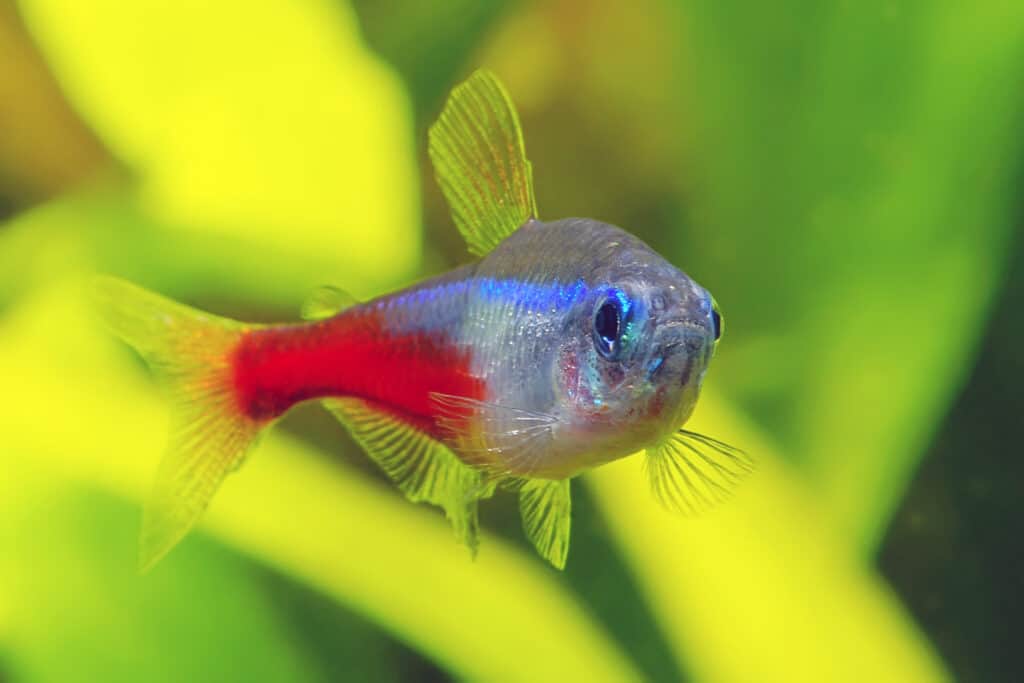
Neon tetras bring a bright, multicolored experience to your tank.
©Grigorev Mikhail/Shutterstock.com
Much like the ember tetra, neon tetras are too small to really be predators of your shrimp. Additionally, these pretty creatures are quick swimmers and tend to swim around within the middle or upper areas of the tank. This creates some visual balance in your tank as shrimp usually hang out near the bottom. If you add a few tetras into your tank, they will probably do some swimming around together too!
4. Dwarf Plecostomus (Hypostomus spp.)
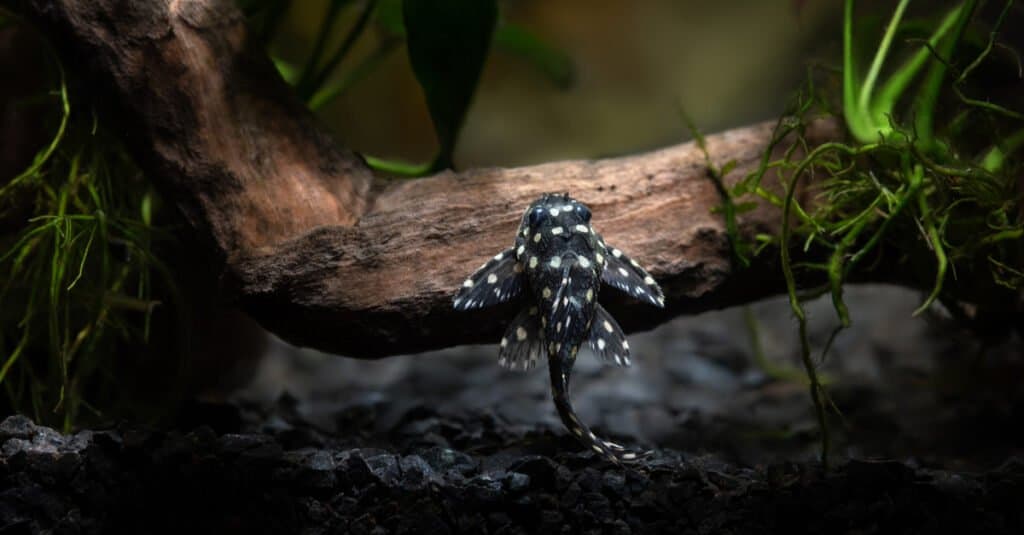
A tiny, lone cleaner fish, a dwarf plecostmus keeps to itself. The type pictured is a dwarf snowball plecostomus.
©otsphoto/Shutterstock.com
Plecostomus fish (or “plecos” as they’re affectionately nicknamed) are essential to any tank. Like the other fish in this list, plecos don’t eat shrimp and aren’t particularly bothered by them either. With many dwarf pleco varieties, you’re likely to find one that catches your eye.
These fish are algae eaters but they also feed on wood, so be sure you have a piece of driftwood your bottom-dwelling friend can munch on. This will help keep pleco well-fed without competing for algae with the shrimp as a food source.
5. Panda Corydora Catfish. (Corydoras panda)
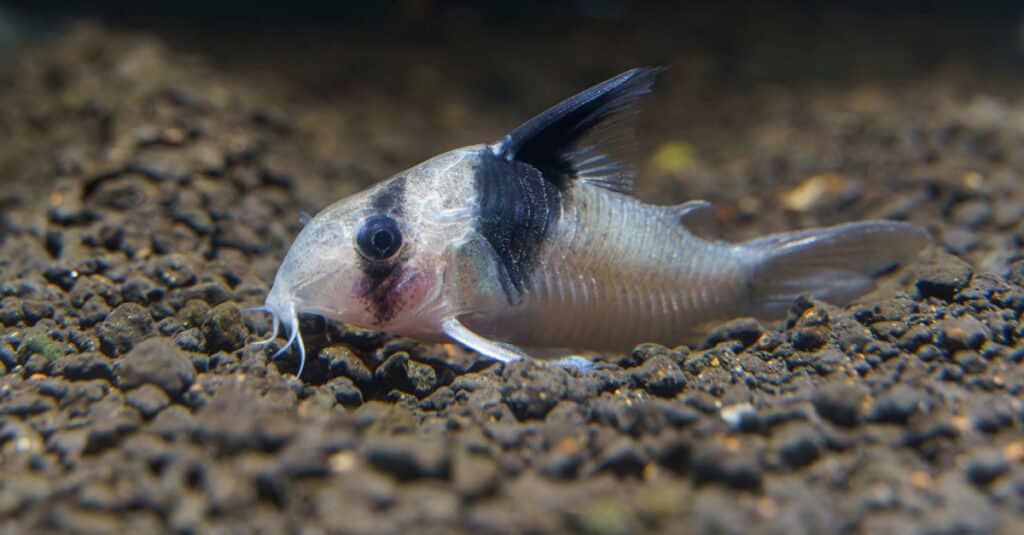
Panda
corydoras are just one type of many corydora species that thrive with shrimp.
©chonlasub woravichan/Shutterstock.com
Panda corydoras, or “corys” for short, are similar to plecos but more active. These fish tend to prefer a group of at least two or three to school together. They will mostly hang out at the bottom of the tank and feed off of debris and bottom-feeder pellets. However, when they’re happy in their environment they will group up and swim around the whole tank.
As with other species, a cory might unintentionally eat a baby shrimp or two. However, with sufficient hiding spaces, your shrimp should be safe.
6. Otocinclus Catfish (Otocinclus spp.)
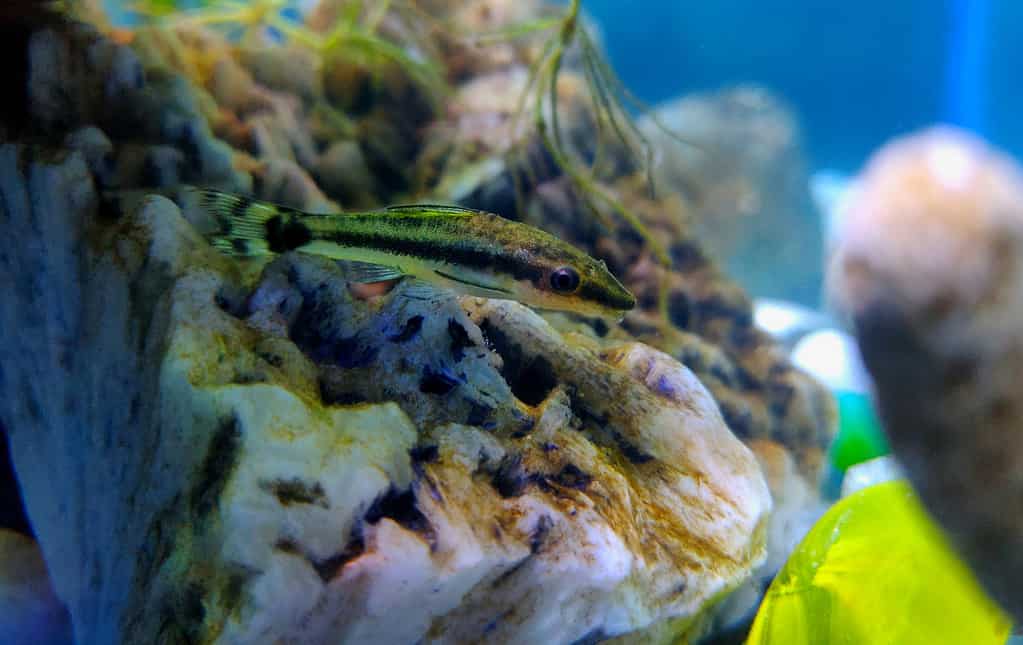
Otocinclus
catfish
are usually just referred to as “otos” are an aquarium favorite.
©Saurabhkumar Singh/iStock / Getty Images Plus via Getty Images
If you’re very concerned about the predation of your shrimp and don’t want to risk potentially losing a few babies, the otos are the perfect addition to your tank! Keep them in groups of six or more to keep them happy. Despite needing quite a few “friends” you can safely get away with a 15-gallon tank for all of the otos and shrimp.
Unlike other catfish species, the otos will be active during the day or night. This means you can actually enjoy seeing these fish being active in your tank.
7. Kuhli Loach (Pangio kuhlii)
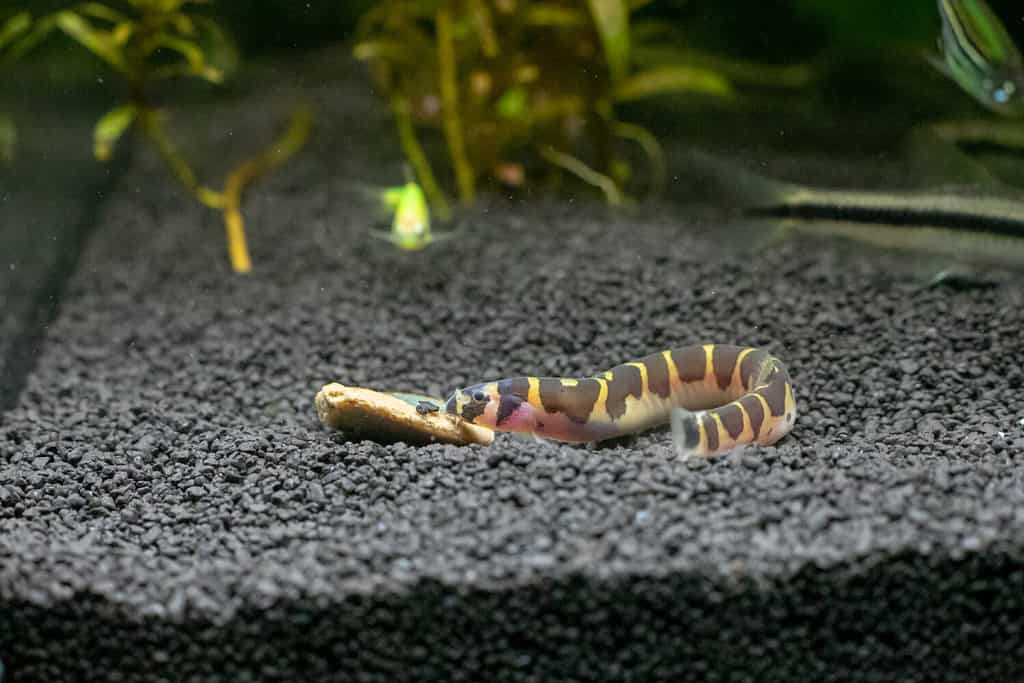
Loaches resemble eels or snakes with their long, slinky bodies.
©Olga Chezhina/Shutterstock.com
Kuhli loaches are interesting-looking creatures that can grow to be about 4 inches long. They prefer having a few buddies of the same species in the tank to ensure safe exploration, so aim to get between three to six to properly stock your tank.
Not only do kuhli loaches not eat algae, so they’re not competing for the shrimp’s food, but they also leave shrimp alone entirely. This is not true of all loach species, so be sure you’re getting kuhli loaches if you intend to keep them as tank mates for your shrimp! Kuhli loaches are very peaceful fish and, in a large enough tank, can also be kept with tetras and rasboras.
8. Guppies (Poecilia reticulata)
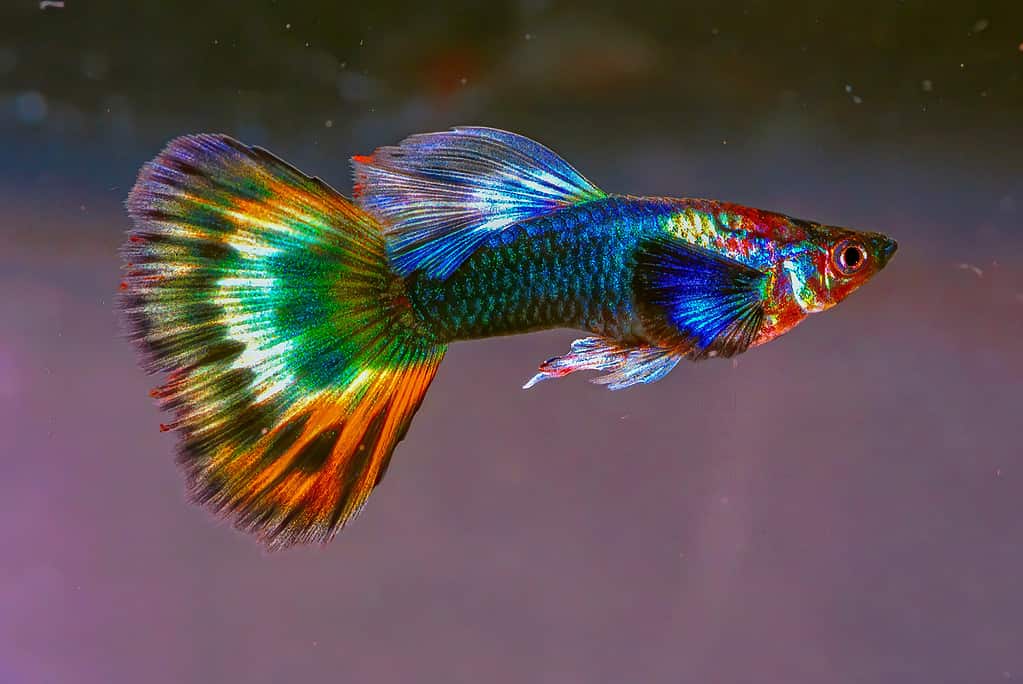
Guppies are known to be good additions to aquariums for any level of hobbyist.
©Karel Zahradka/Shutterstock.com
It’s no wonder guppies are some of the most common fish in the aquarium pet trade: they are beautiful and come in tons of varieties, they’re peaceful, and they’re easy to care for. Guppies that are well-fed won’t pay much mind to your shrimp, though if there isn’t significant coverage for the shrimplets they might be made a snack by your guppies.
Guppies easily reproduce, so if this isn’t something you want to deal with, try to get only female guppies. They can easily overwhelm a tank which can make maintaining a shrimp population difficult.
9. Pygmy Corydora (Corydoras pygmaeus)

A pygmy corydora measures to be just an inch long!
©Pavaphon Supanantananont/Shutterstock.com
Not only are these tiny, friendly fish happy to share a tank with shrimp, but they’re also quite striking! Pygmy corydoras are shimmery fish that are happiest in a school with at least five others of their kind. They can eat algae wafers like shrimp do, so be sure you’re giving enough food to avoid competition.
Given their tiny size, you can have a school of pygmy corydoras and shrimp in a 10-gallon tank.
10. Chili Rasbora (Boraras brigittae)

Chili rasbora are a type of “nanofish” meaning they grow to be under an inch long at maturity.
©boban_nz/Shutterstock.com
Another bright red addition to your tank, these nanofish are too small to bully their shrimp tank mates! Chili rasboras are a bit more suited for aquarists with some experience as they can be quite sensitive to changes in the water parameters. It is recommended to keep them in a group of at least eight.
As middle water-column occupiers, there is always some activity to look forward to if you choose to keep these fish. Blue shrimp would be a great shrimp to keep with these fish as their bright, contrasting colors will lead to even more visual intrigue in your tank.
11. Endler’s Livebearer (Poecilia wingei)
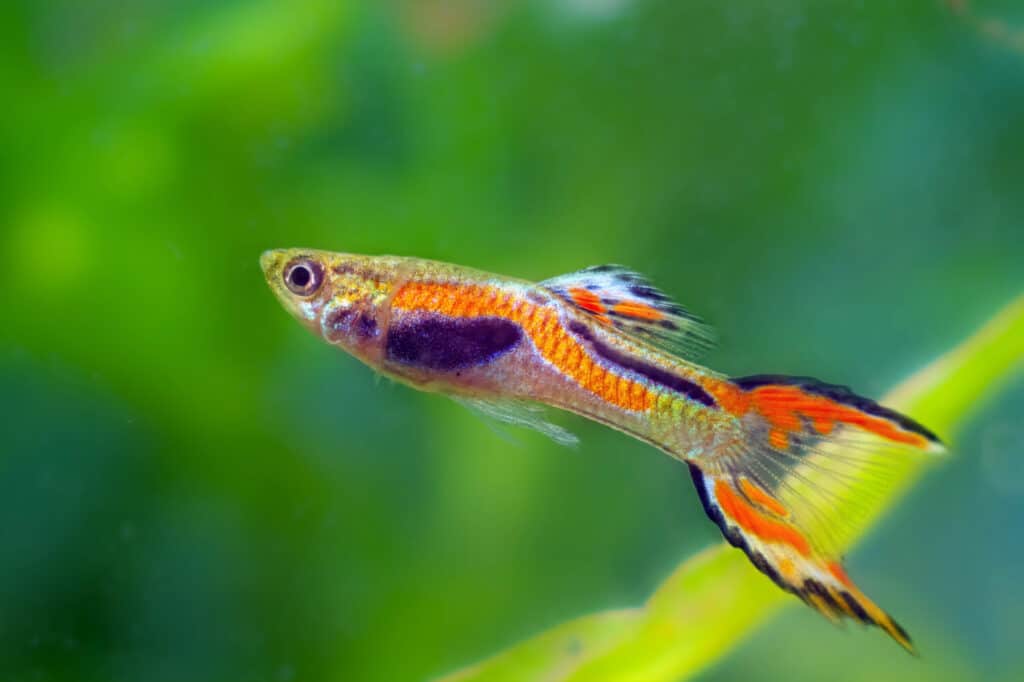
While commonly mistaken for guppies, the Endler’s livebearer is a closely related yet different species.
©Aleron Val/Shutterstock.com
These guppy relatives are a bit more slender but every bit as striking as a “regular” guppy. They also boast different tail and fin styles which can add a different aesthetic to your tank. Like other guppies, the Endler’s livebearers are social and peaceful. They will not bother your shrimp unless they’re underfed.
Since they’re closely related to P. reticulata, if they’re kept in the same tank they can interbreed. However, the offspring would be sterile.
12. Harlequin Rasbora (Trigonostigma heteromorpha)
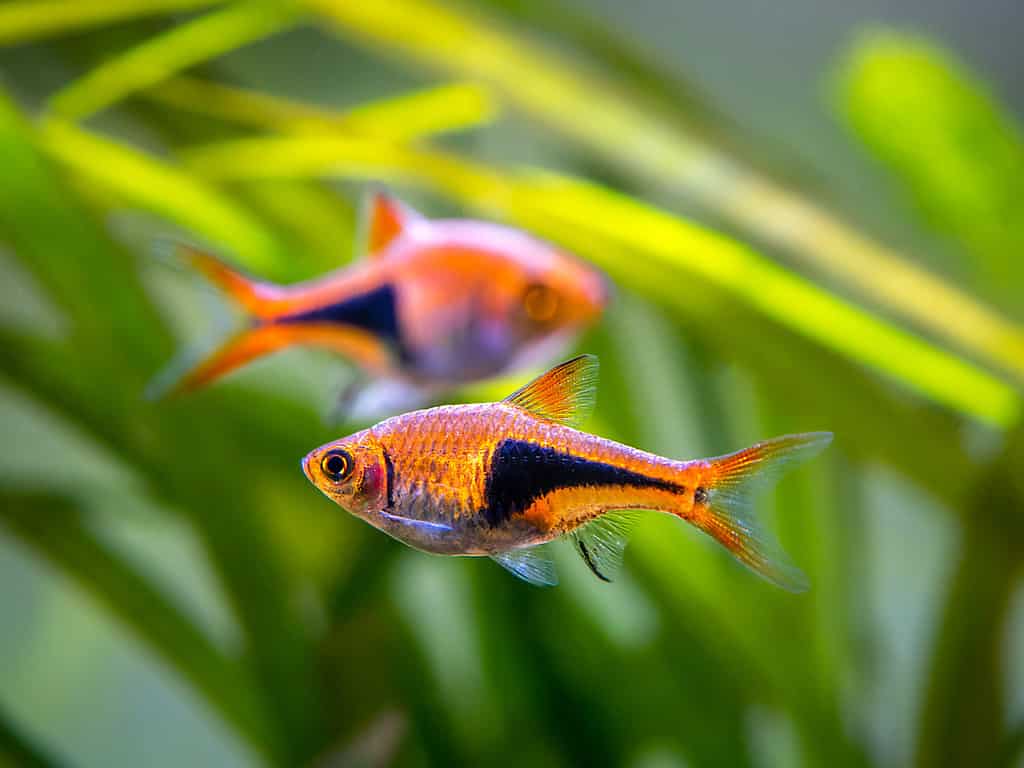
This type of rasbora has a metallic look to its scales, punctuated by a deep black triangular marking on its side.
©Joan Carles Juarez/Shutterstock.com
Harlequin rasboras are another non-confrontational fish that can make for one of the best tank mates for any type of shrimp. They live in the middle to top of the tank typically, so there is not a ton of interaction with the shrimp unless the shrimp venture into the middle of the water column. Even when they do interact, harlequin rasboras would rather eat insects or flake food.
13. Galaxy Rasbora (Danio margaritatus)
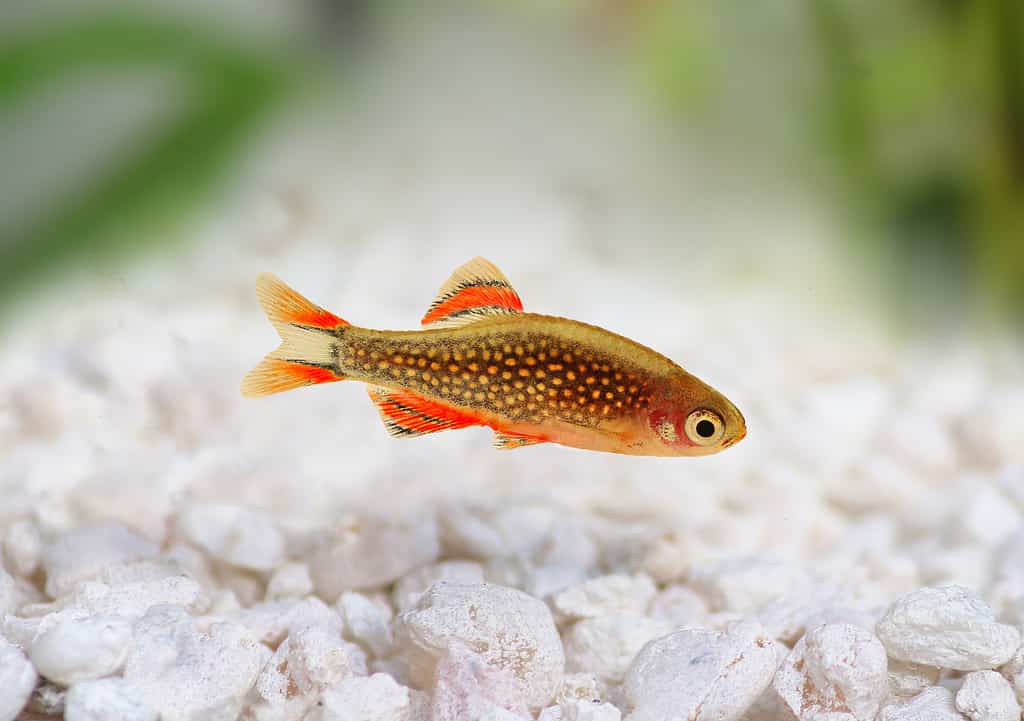
The galaxy rasbora is named for the spots on its side resembling stars in the sky.
©Mirko_Rosenau/ via Getty Images
Another suitable tank mate for your shrimp is galaxy rasboras. They like to stay in the middle or upper areas of the tank so there is minimal interaction or competition for food. They’re also attractive-looking fish and love plenty of space to swim around. Galaxy rasboras can be kept with other species of fish, though at first, they might shy away from interaction. If you add this fish to your tank, be sure their requirements are compatible with the other tank mates.
14. Pencil Fish (Nannostomus spp.)
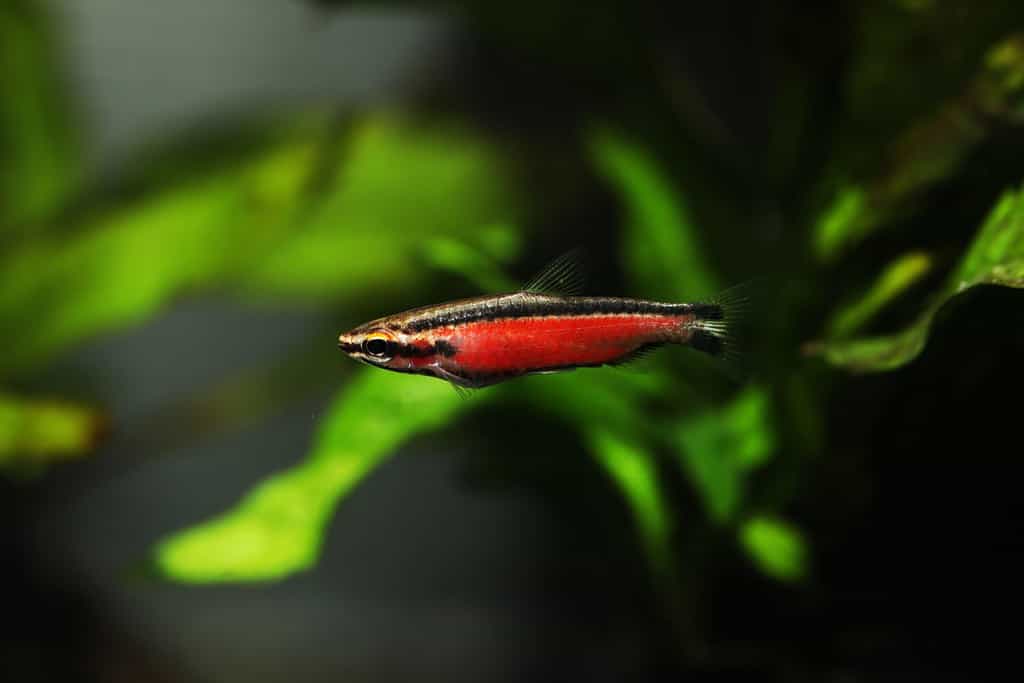
These intensely red fish love to swim in groups near the surface.
©Pavaphon Supanantananont/Shutterstock.com
Pencil fish have various species within the genus that have different colors and swimming behaviors. N. eques, or hockeystick pencilfish, have a peculiar habit of swimming at a 45° angle! They prefer being in groups of six or more, so be sure you have a tank large enough to accommodate them as well as the shrimp.
15. Clown Killifish (Epiplatys annulatus)

Another name for this striped fish is “rocket killies.”
©boban_nz/Shutterstock.com
If you’re looking for a top-dwelling fish to add to your shrimp tank, look no further. Clown killifish mostly stay at the top of the tank, so you will have little to no issues with these fish harassing your shrimp or eating the fry. They grow just short of 1.5 inches, so you don’t need a large tank to have a few of this type of species.
16. African Dwarf Frog (Hymenochirus spp.)
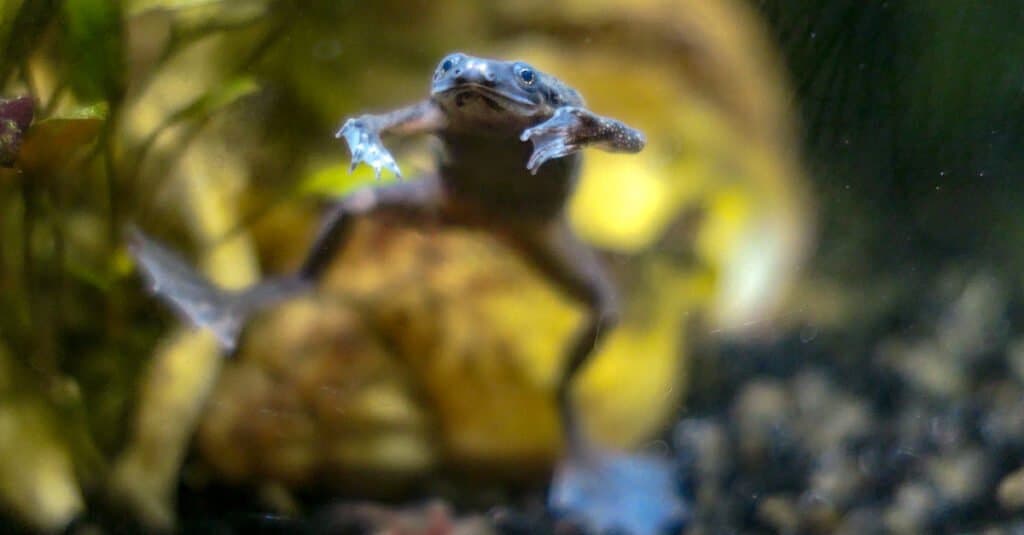
Many species on this list are “dwarfs” and the African dwarf frog is no exception!
©Charlie Tyack/Shutterstock.com
These fully aquatic frogs might be able to eat young shrimp if there isn’t sufficient cover. However, they’re notoriously bad hunters as many owners will note. This means your adult shrimp are likely to survive an encounter with these guys. African dwarf frogs can live in the water full-time but do need to come up to the surface to breathe.
17. More Shrimp!

Shrimp can be an easily maintained animal to keep once the water is cycled properly and the shrimp are acclimated.
©Alex Stemmers/Shutterstock.com
You can house different types of shrimp together without concern of predation. This can be a fun venture as shrimp come in many shades and patterns. Be sure you’re choosing species that have the same water requirements, as some prefer different water hardnesses, pH levels, and temperatures.
The ultimate best tank mates for shrimp are, of course, other shrimp! You can house different types of shrimp together without concern of predation. This can be a fun venture as shrimp come in many shades and patterns. Be sure you’re choosing species that have the same water requirements, as some prefer different water hardnesses, pH levels, and temperatures. This goes for any species of animals you keep together.
Amano shrimp (Caridina multidentata), ghost shrimp (Palaemonetes paludosus), and cherry shrimp (Neocaridina davidi) are some of the more popular types of fish to keep. Ghost shrimp are fairly hardy to most conditions, but Neocaridina and Cardina species are a bit more specific.
Neocaridina shrimp like to have water between 68° to 80°F and a pH between 6.5-8.0 Other parameters, such as TDS (total dissolved solids) should be between 180-400 parts per million, or ppm. These ranges might be more specific depending on the species of Neocaridina you choose to keep. Be sure you’re comparing their ideal living conditions with any potential tank mates to guarantee compatibility!
Caridina species prefer a lower pH, of 6.0-6.8, and TDS cannot exceed 150ppm. They also prefer cooler temperatures not exceeding 74°F. As you can see, this is quite a different range than the Neocaridina. Other factors, such as potassium, ammonium, nitrate, and nitrite levels, can also differ. Doing thorough research before delving into this hobby is essential, as shrimp (and other fish) can get pricey!
Tank Mates to Avoid
Bettas (Betta splendens)

Betta fish are gorgeous animals that make for a great “centerpiece” fish.
©Digital Art StudioTH/Shutterstock.com
“Fighting fish” is not a misnomer for this gorgeous fish. Bettas can be particularly aggressive to any other species in the tank, especially to more of its own. If the shrimp is small enough to fit into the betta’s mouth, chances are, that’s where it will wind up. If your betta fish doesn’t eat your shrimp, they still might harass them or eat any babies that may be born in the tank.
Bettas are best kept on their own or with bottom-dwelling species such as corydoras or plecostomus.
Cichlids (Cichlidae spp.)
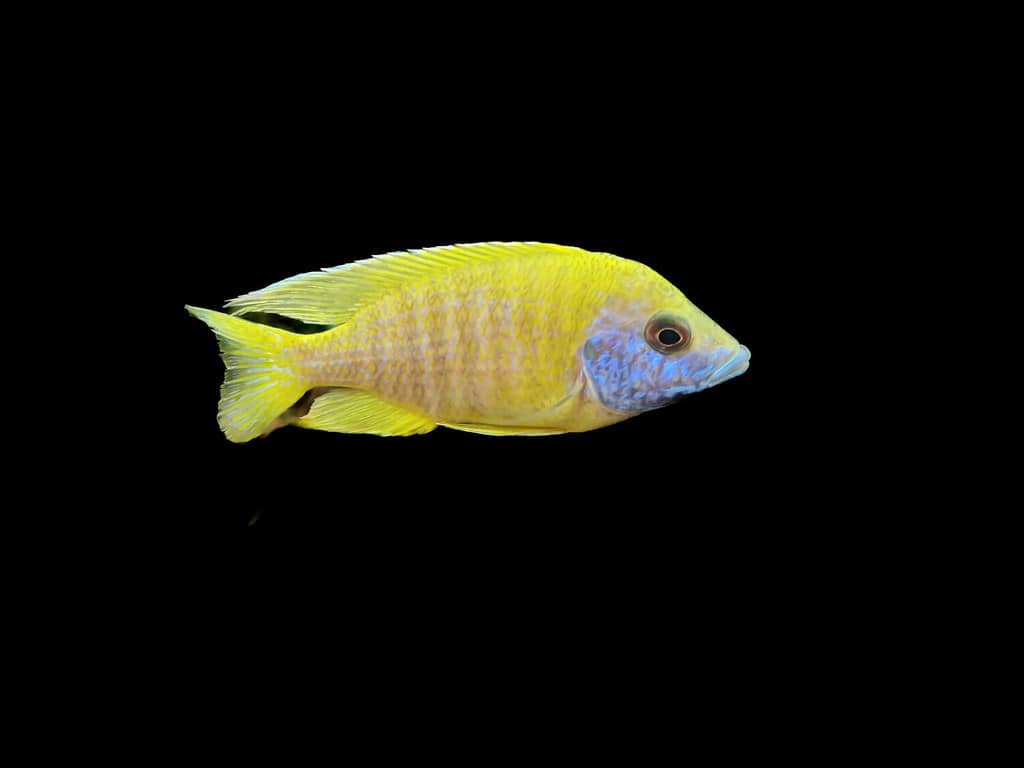
Many different varieties of cichlids exist, and unfortunately, none are suitable to live with shrimp.
©NiAk Stock/Shutterstock.com
Cichlids are known to be quite aggressive fish. They will make snacks out of baby shrimp and mercilessly eat any established shrimp population you have. Given that certain shrimp can be expensive, cichlids are not the best tank mates for shrimp.
Goldfish (Carassius auratus)
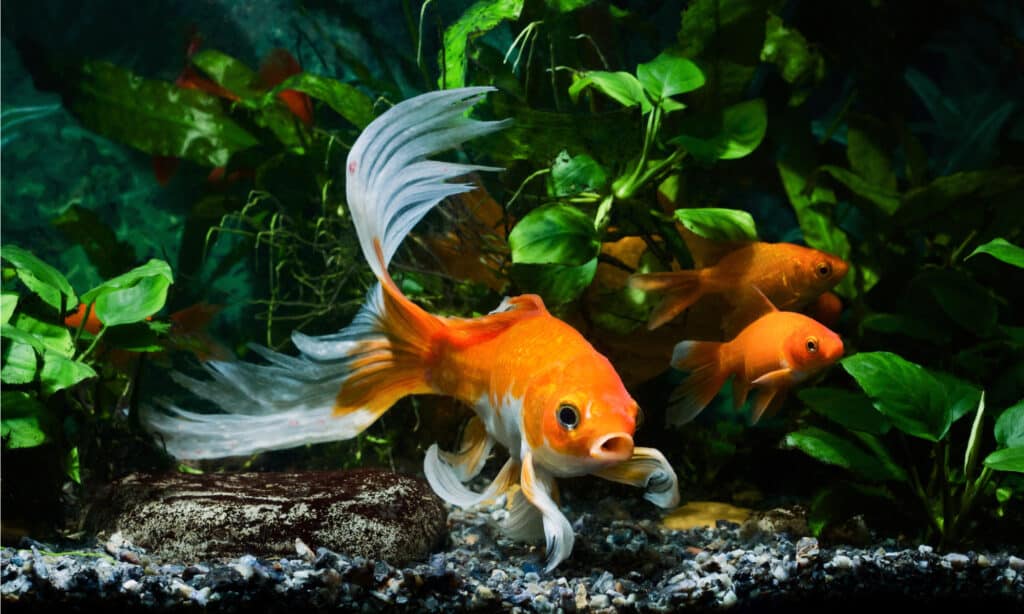
Goldfish are “indeterminate growers” which means that under proper care, they will not stop growing until they die.
©Aleron Val/Shutterstock.com
This classic fish is a fairly friendly one that will get along well with species of fish. However, if it’s bite-sized to your goldfish, it’ll most likely get eaten. It’s not necessarily done with malicious intent, though your shrimp might feel differently!
Pea Puffers (Carinotetraodon travancoricus)

Pea puffers are the smallest
pufferfish
in the world and are freshwater dwellers.
©Toxotes Hun-Gabor Horvath/Shutterstock.com
Despite their cute and petite appearance, pea puffers are carnivorous fish notorious for bullying (and eating) smaller tank mates. Shrimp are a perfect menu item for these precious, but vicious, creatures. Pea puffers ideally would live in a species-only tank due to their aggressive nature.
Crayfish (Procambarus alleni)
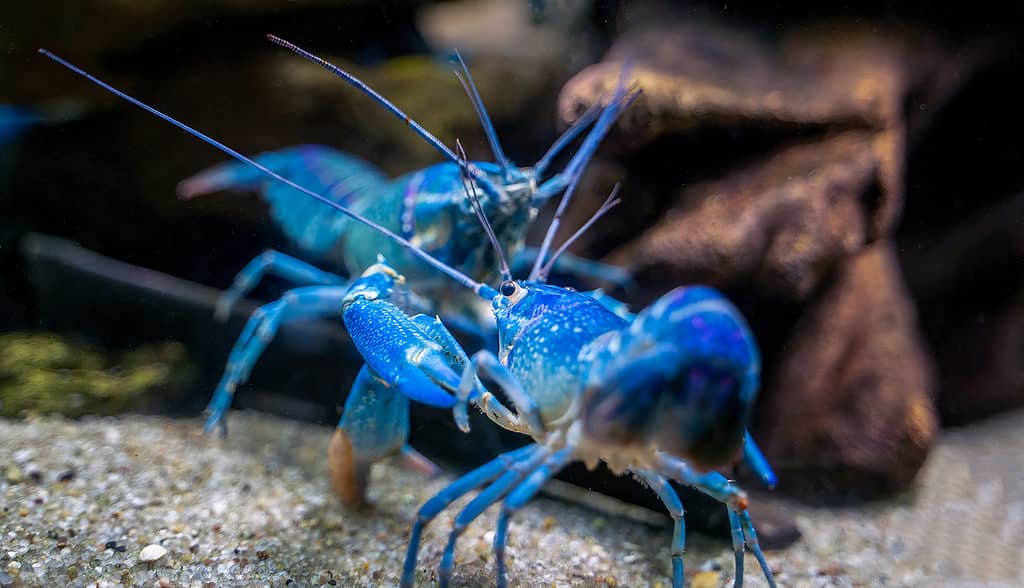
Crayfish are also known to feed on other soft crayfish after they’ve just molted.
©iStock.com/Arpan
While related to shrimp, crayfish will not hesitate to make a snack out of adult shrimp and their shrimplets. You might get lucky with a docile and well-fed crayfish that pays no mind to your little crustaceans, but ultimately it’s not worth the risk to your shrimp population to keep these creatures together.
Thank you for reading! Have some feedback for us? Contact the AZ Animals editorial team.








